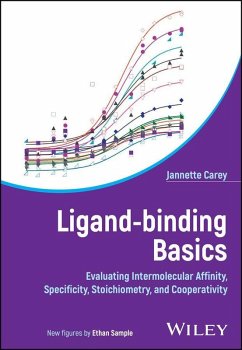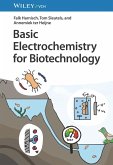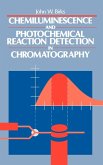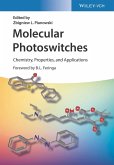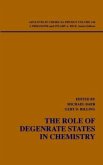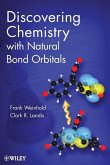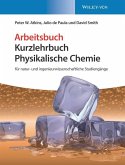Jannette Carey
Ligand-Binding Basics
Evaluating Intermolecular Affinity, Specificity, Stoichiometry, and Cooperativity
Jannette Carey
Ligand-Binding Basics
Evaluating Intermolecular Affinity, Specificity, Stoichiometry, and Cooperativity
- Gebundenes Buch
- Merkliste
- Auf die Merkliste
- Bewerten Bewerten
- Teilen
- Produkt teilen
- Produkterinnerung
- Produkterinnerung
A concise and accessible textbook covering ligand-binding theory in chemistry, biology, and drug development
In Ligand-binding Basics: Evaluating Intermolecular Affinity, Specificity, Stoichiometry, and Cooperativity, accomplished chemist Jannette Carey introduces ligand binding in a thorough and practical way for those new to the topic, as well as anyone seeking a connection between theory and experiment. Using a minimum of mathematical formalism, this book offers analytical rigor while remaining accessible to non-specialist practitioners. It provides readers with the skills they need to…mehr
Andere Kunden interessierten sich auch für
![Basic Electrochemistry for Biotechnology Basic Electrochemistry for Biotechnology]() Falk HarnischBasic Electrochemistry for Biotechnology42,99 €
Falk HarnischBasic Electrochemistry for Biotechnology42,99 €![Chemiluminescence and Photochemical Reaction Detection in Chromatography Chemiluminescence and Photochemical Reaction Detection in Chromatography]() John W. Birks (Hrsg.)Chemiluminescence and Photochemical Reaction Detection in Chromatography263,99 €
John W. Birks (Hrsg.)Chemiluminescence and Photochemical Reaction Detection in Chromatography263,99 €![Molecular Photoswitches Molecular Photoswitches]() ZL PianowskiMolecular Photoswitches399,00 €
ZL PianowskiMolecular Photoswitches399,00 €![The Role of Degenerate States in Chemistry, Volume 124 The Role of Degenerate States in Chemistry, Volume 124]() Michael Baer / Gert Due Billing (Hgg.)The Role of Degenerate States in Chemistry, Volume 124351,99 €
Michael Baer / Gert Due Billing (Hgg.)The Role of Degenerate States in Chemistry, Volume 124351,99 €![Electrochemical Processes in Biological Systems Electrochemical Processes in Biological Systems]() Electrochemical Processes in Biological Systems123,99 €
Electrochemical Processes in Biological Systems123,99 €![Discovering Chemistry Discovering Chemistry]() Frank WeinholdDiscovering Chemistry89,99 €
Frank WeinholdDiscovering Chemistry89,99 €![Kurzlehrbuch Physikalische Chemie Kurzlehrbuch Physikalische Chemie]() Peter W. AtkinsKurzlehrbuch Physikalische Chemie34,90 €
Peter W. AtkinsKurzlehrbuch Physikalische Chemie34,90 €-
-
-
A concise and accessible textbook covering ligand-binding theory in chemistry, biology, and drug development
In Ligand-binding Basics: Evaluating Intermolecular Affinity, Specificity, Stoichiometry, and Cooperativity, accomplished chemist Jannette Carey introduces ligand binding in a thorough and practical way for those new to the topic, as well as anyone seeking a connection between theory and experiment. Using a minimum of mathematical formalism, this book offers analytical rigor while remaining accessible to non-specialist practitioners. It provides readers with the skills they need to analyze their own binding data or published results, helping them develop an intuitive grasp of ligand-binding phenomena integrated with structural and thermodynamic understanding.
Topics covered include:
_ Application of the principles of equilibrium, mass action, and mass balance to derive the basic equations that describe all binding processes
_ Recommended approaches for plotting and graphical analysis of binding data
_ Strategies for designing, analyzing, interpreting, and troubleshooting experiments from the perspective of ligand-binding theory
_ Review of selected examples that illustrate integration of structural and thermodynamic analysis
Perfect for students and educators in chemistry, biochemistry, molecular biology, and pharmaceutical science, Ligand-binding Basics will also appeal to practitioners who aim to study ligand binding in any molecular system.
In Ligand-binding Basics: Evaluating Intermolecular Affinity, Specificity, Stoichiometry, and Cooperativity, accomplished chemist Jannette Carey introduces ligand binding in a thorough and practical way for those new to the topic, as well as anyone seeking a connection between theory and experiment. Using a minimum of mathematical formalism, this book offers analytical rigor while remaining accessible to non-specialist practitioners. It provides readers with the skills they need to analyze their own binding data or published results, helping them develop an intuitive grasp of ligand-binding phenomena integrated with structural and thermodynamic understanding.
Topics covered include:
_ Application of the principles of equilibrium, mass action, and mass balance to derive the basic equations that describe all binding processes
_ Recommended approaches for plotting and graphical analysis of binding data
_ Strategies for designing, analyzing, interpreting, and troubleshooting experiments from the perspective of ligand-binding theory
_ Review of selected examples that illustrate integration of structural and thermodynamic analysis
Perfect for students and educators in chemistry, biochemistry, molecular biology, and pharmaceutical science, Ligand-binding Basics will also appeal to practitioners who aim to study ligand binding in any molecular system.
Produktdetails
- Produktdetails
- Verlag: Wiley / Wiley & Sons
- Artikelnr. des Verlages: 1W119878420
- 1. Auflage
- Seitenzahl: 256
- Erscheinungstermin: 2. Oktober 2025
- Englisch
- Abmessung: 246mm x 173mm x 20mm
- Gewicht: 612g
- ISBN-13: 9781119878421
- ISBN-10: 111987842X
- Artikelnr.: 65689223
- Herstellerkennzeichnung
- Libri GmbH
- Europaallee 1
- 36244 Bad Hersfeld
- gpsr@libri.de
- Verlag: Wiley / Wiley & Sons
- Artikelnr. des Verlages: 1W119878420
- 1. Auflage
- Seitenzahl: 256
- Erscheinungstermin: 2. Oktober 2025
- Englisch
- Abmessung: 246mm x 173mm x 20mm
- Gewicht: 612g
- ISBN-13: 9781119878421
- ISBN-10: 111987842X
- Artikelnr.: 65689223
- Herstellerkennzeichnung
- Libri GmbH
- Europaallee 1
- 36244 Bad Hersfeld
- gpsr@libri.de
Jannette Carey has been a member of the Chemistry faculty at Princeton University for over thirty years, where she developed and teaches a two-term sequence in biophysical chemistry that is accessible to early graduate and advanced undergraduate students in a wide range of disciplines. Her biophysical research is focused on unifying the thermodynamic and structural basis for macromolecular interactions.
About the Cover xi Introduction xiii 1 The Biology of Molecules 1 Why Study Intermolecular Interactions Quantitatively? 1 Equilibrium and Kinetics 2 Thermodynamic Definitions of Affinity and Specificity 3 The Affinity/Specificity Map 6 Biology Requires Optimization of Affinity and Specificity 8 The Special Case of Protein-DNA Interactions 8 2 General Theory for Reversible Ligand Binding 10 Definition of Ligand and Titration 10 Affinity, Specificity, Stoichiometry, and Cooperativity 10 Ligand-binding Theory: Relationship to Experiment 13 General Theory for Reversible Ligand Binding: Rooted in Chemical Equilibrium 14 General Theory for Reversible Ligand Binding: Quantitative Treatment 14 The Case of 1:1 Binding 15 General Theory for Reversible Ligand Binding: Conservation of Mass 17 Definition of
18 The Basic Equation for 1:1 Binding 19 The Single Most Important Thing You Can Learn in This Book 20 The Example of Heme Binding to Apocytochrome c 21 The Rectangular Hyperbola 22 The Binding Isotherm 23 Plot of
vs. [H f ] 24 General Theory for Reversible Ligand Binding: Role of Mass Action 25 Plot of [AH]vs.[H t ] with Fixed K 27 Determination of K d from Experiment 28 Plot of [AH]vs.[H t ] with Fixed [A t ] 29 Determining Molar Ratio from Experiment 29 About Activity 31 3 Graphical Analysis 33 Limitations of Direct Plots 33 The Semi-log Plot 34 Breadth of the Semi-log Plot 36 Myoglobin and Hemoglobin 38 Advantages of the Direct and Semi-log Plots of Binding Data 40 Linear Transforms of the Basic Binding Equation 40 Common Linearizations 41 Requirements of the Linear Regression Model 41 A Linear Model May Misrepresent the Physical Process 43 Deviations from Linearity Are Hard to Detect or Interpret 44 Linear Transforms Distort Data Completeness 44 Linear Transforms Invite - Even Require - Extrapolation 46 Linear Transforms Falsely Promise Both K and Molar Ratio from a Single Dataset 47 Summary about Linear Treatments of Binding Data 47 Simulation Is Just as Good as Fitting, Given Realistic Experimental Errors 50 4 Binding of Multiple Ligands 52 Conservation of Mass Outside the 1:1 Case 52 Redefine
to Accommodate Any Molar Ratio 53 Accounting for the Definition of Molecule 54 Generalizing to Integer Multiples of 1:1 54 The Langmuir Equation for Any Molar Ratio with Sites of Identical Affinity and No Cooperativity 56 Adair Equation for Any Number of Binding Events 57 The Langmuir Equation vs. the Adair Equation 60 Thermodynamic Linkage 61 Two Classes of Sites with Different Affinities 62 Binding Isotherms for Multiple Sites with Different Affinities 62 Summary 66 5 How to Determine K d and Molar Ratio Experimentally 67 Stoichiometric Titration First 68 Amounts of Materials 69 Assigning Partners 69 Choice of Experimental Observables 70 Choosing Solution Conditions 70 How Many Data Points? 71 Range-Finding Stoichiometric Titration 72 Visualizing Results 73 Range-Finding Asymptotic Titration to Estimate K d 74 Data Analysis 75 Practicalities about Experimental Error 75 Statistical Approaches to Estimate the Breakpoint 76 Refined Asymptotic Titration 76 Designing an Experiment to Refine K d 77 Calculating Free Ligand Concentration 78 Refining the Value of Molar Ratio 79 Example of ArgR/DNA Binding 79 Plotting the Data 81 Deriving K d from the Data 81 Summary 81 6 Cooperativity 83 Facilitated and Antagonized Binding 83 Free Energy Definition of Cooperative Binding 84 Chemical Potential Diagram for Cooperative Binding 86 Cooperativity as Non-additivity 87 Reciprocity of Cooperative Effects 88 Limitations of Linear Transforms for Cooperative Interactions 88 Microscopic View of Species Distribution 89 Homotropic and Heterotropic Cooperativity 90 Cooperativity Affects Specificity as Well as Affinity 92 Cooperativity Is the Third Axis of the Affinity/Specificity Map 94 Quantifying Homotropic Cooperativity 95 Negative Homotropic Cooperativity 95 A Practical Advantage of Negative Cooperativity 97 Positive Cooperativity and the Ligand Concentration Interval 97 Importance of Individual-site Isotherms and Species Distribution 100 Species Distributions by Specialized Experimental Methods 101 The Many Forms of Cooperativity 103 Emergent Properties 103 Connectivity and Search Entropy 104 Breakdown of Additivity in Complex Systems 105 Statistical Effects 107 Relevance of Non-additivity for Analysis of Mutations 110 Universality and Promiscuity of Cooperativity 111 Proteins as Gestalt Objects 113 Summary 115 7 Theoretical and Method-specific Troubleshooting 116 Equilibrium and Nonequilibrium Methods 116 Accessible Concentration Ranges Limit Accessible K d Values 116 Signal from Ligand or Target? 118 Separation-based Methods 118 Filter Binding 119 Gel Retardation or EMSA 120 Gel Filtration 121 Hummel and Dreyer Chromatography 121 Equilibrium Dialysis 122 UV Absorbance 123 CD Spectroscopy 123 Fluorescence 124 NMR 124 ITC 125 AUC 129 SPR 129 MS 131 8 Allostery 133 An Historical Overview 133 Facilitated Binding 135 Elaboration of the MWC Model 136 Relaxed Monomers and Tense Multimers 136 Positive Homotropic Cooperativity Only 137 Artifactual Origins of Affinity Heterogeneity 138 Relaxation of Multimers by Ligand Binding 138 Koshland's Sequential (Asymmetric) Model 140 G3Pase Was Heterogeneous, Not Negatively Cooperative 141 Many Models Fit the Hemoglobin Data 142 Advantages of Negative Cooperativity for Molecular Insight 143 Biology of Negative Cooperativity 145 Structural Analysis Cannot Solve Allostery 146 Allostery without Cooperativity 147 Summary 148 9 Lessons on Affinity and Specificity from Host/Guest Chemistry 149 2D Representations of 3D Objects 149 Early Hosts Were Linear and Flexible 150 Design of Molecular Properties 151 Very Weak Affinity and No Detectable Specificity 151 Later Hosts Pre-organized in Bound Conformation 152 Enormous Gains in Affinity and Specificity 152 Bonds between Host and Guest Are Identical 153 Lessons from the Host/Guest Chemistry 153 Rational Design of Affinity and Specificity 153 Affinity and Specificity Accrue in Parallel 155 Cryptic Contributions Can Dominate Binding 156 10 Reconciling Structure and Thermodynamics in Molecular Interactions 157 Thermodynamics of Molecular Interactions 158 Structural Analysis of Bonding Does Not Predict Binding 160 The Goldilocks Region of Affinity/Specificity Space 162 Conformational Rearrangement upon Binding Decouples Affinity and Specificity 163 A Reservoir of Adaptability 164 No Simple Reconciliation of Structural and Energetic Views 165 Implications for Drug Design 166 11 Applications in Modern Drug Development 167 Background 167 Technological Developments 167 Crystal Structures 168 Trapped High-energy States 168 Another Example 171 Computational Methods 175 High-throughput Assays 177 Druggability 178 Irrational Drug Design 180 A New Workflow 181 Appendix A Ligand-binding Study Questions 182 Appendix B Thought Experiments 195 Appendix C Derivations 197 Appendix D Simulation and Fitting 201 Simulation 201 Fitting 203 Appendix E About the Hill Equation 208 Deriving the Hill Equation 208 The Hill Equation as a Limit of the Adair Equation 209 On Applying the Hill Equation to Quantify Cooperativity 210 Appendix F Stereo Viewing 212 Bibliography 215 Index 227
18 The Basic Equation for 1:1 Binding 19 The Single Most Important Thing You Can Learn in This Book 20 The Example of Heme Binding to Apocytochrome c 21 The Rectangular Hyperbola 22 The Binding Isotherm 23 Plot of
vs. [H f ] 24 General Theory for Reversible Ligand Binding: Role of Mass Action 25 Plot of [AH]vs.[H t ] with Fixed K 27 Determination of K d from Experiment 28 Plot of [AH]vs.[H t ] with Fixed [A t ] 29 Determining Molar Ratio from Experiment 29 About Activity 31 3 Graphical Analysis 33 Limitations of Direct Plots 33 The Semi-log Plot 34 Breadth of the Semi-log Plot 36 Myoglobin and Hemoglobin 38 Advantages of the Direct and Semi-log Plots of Binding Data 40 Linear Transforms of the Basic Binding Equation 40 Common Linearizations 41 Requirements of the Linear Regression Model 41 A Linear Model May Misrepresent the Physical Process 43 Deviations from Linearity Are Hard to Detect or Interpret 44 Linear Transforms Distort Data Completeness 44 Linear Transforms Invite - Even Require - Extrapolation 46 Linear Transforms Falsely Promise Both K and Molar Ratio from a Single Dataset 47 Summary about Linear Treatments of Binding Data 47 Simulation Is Just as Good as Fitting, Given Realistic Experimental Errors 50 4 Binding of Multiple Ligands 52 Conservation of Mass Outside the 1:1 Case 52 Redefine
to Accommodate Any Molar Ratio 53 Accounting for the Definition of Molecule 54 Generalizing to Integer Multiples of 1:1 54 The Langmuir Equation for Any Molar Ratio with Sites of Identical Affinity and No Cooperativity 56 Adair Equation for Any Number of Binding Events 57 The Langmuir Equation vs. the Adair Equation 60 Thermodynamic Linkage 61 Two Classes of Sites with Different Affinities 62 Binding Isotherms for Multiple Sites with Different Affinities 62 Summary 66 5 How to Determine K d and Molar Ratio Experimentally 67 Stoichiometric Titration First 68 Amounts of Materials 69 Assigning Partners 69 Choice of Experimental Observables 70 Choosing Solution Conditions 70 How Many Data Points? 71 Range-Finding Stoichiometric Titration 72 Visualizing Results 73 Range-Finding Asymptotic Titration to Estimate K d 74 Data Analysis 75 Practicalities about Experimental Error 75 Statistical Approaches to Estimate the Breakpoint 76 Refined Asymptotic Titration 76 Designing an Experiment to Refine K d 77 Calculating Free Ligand Concentration 78 Refining the Value of Molar Ratio 79 Example of ArgR/DNA Binding 79 Plotting the Data 81 Deriving K d from the Data 81 Summary 81 6 Cooperativity 83 Facilitated and Antagonized Binding 83 Free Energy Definition of Cooperative Binding 84 Chemical Potential Diagram for Cooperative Binding 86 Cooperativity as Non-additivity 87 Reciprocity of Cooperative Effects 88 Limitations of Linear Transforms for Cooperative Interactions 88 Microscopic View of Species Distribution 89 Homotropic and Heterotropic Cooperativity 90 Cooperativity Affects Specificity as Well as Affinity 92 Cooperativity Is the Third Axis of the Affinity/Specificity Map 94 Quantifying Homotropic Cooperativity 95 Negative Homotropic Cooperativity 95 A Practical Advantage of Negative Cooperativity 97 Positive Cooperativity and the Ligand Concentration Interval 97 Importance of Individual-site Isotherms and Species Distribution 100 Species Distributions by Specialized Experimental Methods 101 The Many Forms of Cooperativity 103 Emergent Properties 103 Connectivity and Search Entropy 104 Breakdown of Additivity in Complex Systems 105 Statistical Effects 107 Relevance of Non-additivity for Analysis of Mutations 110 Universality and Promiscuity of Cooperativity 111 Proteins as Gestalt Objects 113 Summary 115 7 Theoretical and Method-specific Troubleshooting 116 Equilibrium and Nonequilibrium Methods 116 Accessible Concentration Ranges Limit Accessible K d Values 116 Signal from Ligand or Target? 118 Separation-based Methods 118 Filter Binding 119 Gel Retardation or EMSA 120 Gel Filtration 121 Hummel and Dreyer Chromatography 121 Equilibrium Dialysis 122 UV Absorbance 123 CD Spectroscopy 123 Fluorescence 124 NMR 124 ITC 125 AUC 129 SPR 129 MS 131 8 Allostery 133 An Historical Overview 133 Facilitated Binding 135 Elaboration of the MWC Model 136 Relaxed Monomers and Tense Multimers 136 Positive Homotropic Cooperativity Only 137 Artifactual Origins of Affinity Heterogeneity 138 Relaxation of Multimers by Ligand Binding 138 Koshland's Sequential (Asymmetric) Model 140 G3Pase Was Heterogeneous, Not Negatively Cooperative 141 Many Models Fit the Hemoglobin Data 142 Advantages of Negative Cooperativity for Molecular Insight 143 Biology of Negative Cooperativity 145 Structural Analysis Cannot Solve Allostery 146 Allostery without Cooperativity 147 Summary 148 9 Lessons on Affinity and Specificity from Host/Guest Chemistry 149 2D Representations of 3D Objects 149 Early Hosts Were Linear and Flexible 150 Design of Molecular Properties 151 Very Weak Affinity and No Detectable Specificity 151 Later Hosts Pre-organized in Bound Conformation 152 Enormous Gains in Affinity and Specificity 152 Bonds between Host and Guest Are Identical 153 Lessons from the Host/Guest Chemistry 153 Rational Design of Affinity and Specificity 153 Affinity and Specificity Accrue in Parallel 155 Cryptic Contributions Can Dominate Binding 156 10 Reconciling Structure and Thermodynamics in Molecular Interactions 157 Thermodynamics of Molecular Interactions 158 Structural Analysis of Bonding Does Not Predict Binding 160 The Goldilocks Region of Affinity/Specificity Space 162 Conformational Rearrangement upon Binding Decouples Affinity and Specificity 163 A Reservoir of Adaptability 164 No Simple Reconciliation of Structural and Energetic Views 165 Implications for Drug Design 166 11 Applications in Modern Drug Development 167 Background 167 Technological Developments 167 Crystal Structures 168 Trapped High-energy States 168 Another Example 171 Computational Methods 175 High-throughput Assays 177 Druggability 178 Irrational Drug Design 180 A New Workflow 181 Appendix A Ligand-binding Study Questions 182 Appendix B Thought Experiments 195 Appendix C Derivations 197 Appendix D Simulation and Fitting 201 Simulation 201 Fitting 203 Appendix E About the Hill Equation 208 Deriving the Hill Equation 208 The Hill Equation as a Limit of the Adair Equation 209 On Applying the Hill Equation to Quantify Cooperativity 210 Appendix F Stereo Viewing 212 Bibliography 215 Index 227
About the Cover xi Introduction xiii 1 The Biology of Molecules 1 Why Study Intermolecular Interactions Quantitatively? 1 Equilibrium and Kinetics 2 Thermodynamic Definitions of Affinity and Specificity 3 The Affinity/Specificity Map 6 Biology Requires Optimization of Affinity and Specificity 8 The Special Case of Protein-DNA Interactions 8 2 General Theory for Reversible Ligand Binding 10 Definition of Ligand and Titration 10 Affinity, Specificity, Stoichiometry, and Cooperativity 10 Ligand-binding Theory: Relationship to Experiment 13 General Theory for Reversible Ligand Binding: Rooted in Chemical Equilibrium 14 General Theory for Reversible Ligand Binding: Quantitative Treatment 14 The Case of 1:1 Binding 15 General Theory for Reversible Ligand Binding: Conservation of Mass 17 Definition of
18 The Basic Equation for 1:1 Binding 19 The Single Most Important Thing You Can Learn in This Book 20 The Example of Heme Binding to Apocytochrome c 21 The Rectangular Hyperbola 22 The Binding Isotherm 23 Plot of
vs. [H f ] 24 General Theory for Reversible Ligand Binding: Role of Mass Action 25 Plot of [AH]vs.[H t ] with Fixed K 27 Determination of K d from Experiment 28 Plot of [AH]vs.[H t ] with Fixed [A t ] 29 Determining Molar Ratio from Experiment 29 About Activity 31 3 Graphical Analysis 33 Limitations of Direct Plots 33 The Semi-log Plot 34 Breadth of the Semi-log Plot 36 Myoglobin and Hemoglobin 38 Advantages of the Direct and Semi-log Plots of Binding Data 40 Linear Transforms of the Basic Binding Equation 40 Common Linearizations 41 Requirements of the Linear Regression Model 41 A Linear Model May Misrepresent the Physical Process 43 Deviations from Linearity Are Hard to Detect or Interpret 44 Linear Transforms Distort Data Completeness 44 Linear Transforms Invite - Even Require - Extrapolation 46 Linear Transforms Falsely Promise Both K and Molar Ratio from a Single Dataset 47 Summary about Linear Treatments of Binding Data 47 Simulation Is Just as Good as Fitting, Given Realistic Experimental Errors 50 4 Binding of Multiple Ligands 52 Conservation of Mass Outside the 1:1 Case 52 Redefine
to Accommodate Any Molar Ratio 53 Accounting for the Definition of Molecule 54 Generalizing to Integer Multiples of 1:1 54 The Langmuir Equation for Any Molar Ratio with Sites of Identical Affinity and No Cooperativity 56 Adair Equation for Any Number of Binding Events 57 The Langmuir Equation vs. the Adair Equation 60 Thermodynamic Linkage 61 Two Classes of Sites with Different Affinities 62 Binding Isotherms for Multiple Sites with Different Affinities 62 Summary 66 5 How to Determine K d and Molar Ratio Experimentally 67 Stoichiometric Titration First 68 Amounts of Materials 69 Assigning Partners 69 Choice of Experimental Observables 70 Choosing Solution Conditions 70 How Many Data Points? 71 Range-Finding Stoichiometric Titration 72 Visualizing Results 73 Range-Finding Asymptotic Titration to Estimate K d 74 Data Analysis 75 Practicalities about Experimental Error 75 Statistical Approaches to Estimate the Breakpoint 76 Refined Asymptotic Titration 76 Designing an Experiment to Refine K d 77 Calculating Free Ligand Concentration 78 Refining the Value of Molar Ratio 79 Example of ArgR/DNA Binding 79 Plotting the Data 81 Deriving K d from the Data 81 Summary 81 6 Cooperativity 83 Facilitated and Antagonized Binding 83 Free Energy Definition of Cooperative Binding 84 Chemical Potential Diagram for Cooperative Binding 86 Cooperativity as Non-additivity 87 Reciprocity of Cooperative Effects 88 Limitations of Linear Transforms for Cooperative Interactions 88 Microscopic View of Species Distribution 89 Homotropic and Heterotropic Cooperativity 90 Cooperativity Affects Specificity as Well as Affinity 92 Cooperativity Is the Third Axis of the Affinity/Specificity Map 94 Quantifying Homotropic Cooperativity 95 Negative Homotropic Cooperativity 95 A Practical Advantage of Negative Cooperativity 97 Positive Cooperativity and the Ligand Concentration Interval 97 Importance of Individual-site Isotherms and Species Distribution 100 Species Distributions by Specialized Experimental Methods 101 The Many Forms of Cooperativity 103 Emergent Properties 103 Connectivity and Search Entropy 104 Breakdown of Additivity in Complex Systems 105 Statistical Effects 107 Relevance of Non-additivity for Analysis of Mutations 110 Universality and Promiscuity of Cooperativity 111 Proteins as Gestalt Objects 113 Summary 115 7 Theoretical and Method-specific Troubleshooting 116 Equilibrium and Nonequilibrium Methods 116 Accessible Concentration Ranges Limit Accessible K d Values 116 Signal from Ligand or Target? 118 Separation-based Methods 118 Filter Binding 119 Gel Retardation or EMSA 120 Gel Filtration 121 Hummel and Dreyer Chromatography 121 Equilibrium Dialysis 122 UV Absorbance 123 CD Spectroscopy 123 Fluorescence 124 NMR 124 ITC 125 AUC 129 SPR 129 MS 131 8 Allostery 133 An Historical Overview 133 Facilitated Binding 135 Elaboration of the MWC Model 136 Relaxed Monomers and Tense Multimers 136 Positive Homotropic Cooperativity Only 137 Artifactual Origins of Affinity Heterogeneity 138 Relaxation of Multimers by Ligand Binding 138 Koshland's Sequential (Asymmetric) Model 140 G3Pase Was Heterogeneous, Not Negatively Cooperative 141 Many Models Fit the Hemoglobin Data 142 Advantages of Negative Cooperativity for Molecular Insight 143 Biology of Negative Cooperativity 145 Structural Analysis Cannot Solve Allostery 146 Allostery without Cooperativity 147 Summary 148 9 Lessons on Affinity and Specificity from Host/Guest Chemistry 149 2D Representations of 3D Objects 149 Early Hosts Were Linear and Flexible 150 Design of Molecular Properties 151 Very Weak Affinity and No Detectable Specificity 151 Later Hosts Pre-organized in Bound Conformation 152 Enormous Gains in Affinity and Specificity 152 Bonds between Host and Guest Are Identical 153 Lessons from the Host/Guest Chemistry 153 Rational Design of Affinity and Specificity 153 Affinity and Specificity Accrue in Parallel 155 Cryptic Contributions Can Dominate Binding 156 10 Reconciling Structure and Thermodynamics in Molecular Interactions 157 Thermodynamics of Molecular Interactions 158 Structural Analysis of Bonding Does Not Predict Binding 160 The Goldilocks Region of Affinity/Specificity Space 162 Conformational Rearrangement upon Binding Decouples Affinity and Specificity 163 A Reservoir of Adaptability 164 No Simple Reconciliation of Structural and Energetic Views 165 Implications for Drug Design 166 11 Applications in Modern Drug Development 167 Background 167 Technological Developments 167 Crystal Structures 168 Trapped High-energy States 168 Another Example 171 Computational Methods 175 High-throughput Assays 177 Druggability 178 Irrational Drug Design 180 A New Workflow 181 Appendix A Ligand-binding Study Questions 182 Appendix B Thought Experiments 195 Appendix C Derivations 197 Appendix D Simulation and Fitting 201 Simulation 201 Fitting 203 Appendix E About the Hill Equation 208 Deriving the Hill Equation 208 The Hill Equation as a Limit of the Adair Equation 209 On Applying the Hill Equation to Quantify Cooperativity 210 Appendix F Stereo Viewing 212 Bibliography 215 Index 227
18 The Basic Equation for 1:1 Binding 19 The Single Most Important Thing You Can Learn in This Book 20 The Example of Heme Binding to Apocytochrome c 21 The Rectangular Hyperbola 22 The Binding Isotherm 23 Plot of
vs. [H f ] 24 General Theory for Reversible Ligand Binding: Role of Mass Action 25 Plot of [AH]vs.[H t ] with Fixed K 27 Determination of K d from Experiment 28 Plot of [AH]vs.[H t ] with Fixed [A t ] 29 Determining Molar Ratio from Experiment 29 About Activity 31 3 Graphical Analysis 33 Limitations of Direct Plots 33 The Semi-log Plot 34 Breadth of the Semi-log Plot 36 Myoglobin and Hemoglobin 38 Advantages of the Direct and Semi-log Plots of Binding Data 40 Linear Transforms of the Basic Binding Equation 40 Common Linearizations 41 Requirements of the Linear Regression Model 41 A Linear Model May Misrepresent the Physical Process 43 Deviations from Linearity Are Hard to Detect or Interpret 44 Linear Transforms Distort Data Completeness 44 Linear Transforms Invite - Even Require - Extrapolation 46 Linear Transforms Falsely Promise Both K and Molar Ratio from a Single Dataset 47 Summary about Linear Treatments of Binding Data 47 Simulation Is Just as Good as Fitting, Given Realistic Experimental Errors 50 4 Binding of Multiple Ligands 52 Conservation of Mass Outside the 1:1 Case 52 Redefine
to Accommodate Any Molar Ratio 53 Accounting for the Definition of Molecule 54 Generalizing to Integer Multiples of 1:1 54 The Langmuir Equation for Any Molar Ratio with Sites of Identical Affinity and No Cooperativity 56 Adair Equation for Any Number of Binding Events 57 The Langmuir Equation vs. the Adair Equation 60 Thermodynamic Linkage 61 Two Classes of Sites with Different Affinities 62 Binding Isotherms for Multiple Sites with Different Affinities 62 Summary 66 5 How to Determine K d and Molar Ratio Experimentally 67 Stoichiometric Titration First 68 Amounts of Materials 69 Assigning Partners 69 Choice of Experimental Observables 70 Choosing Solution Conditions 70 How Many Data Points? 71 Range-Finding Stoichiometric Titration 72 Visualizing Results 73 Range-Finding Asymptotic Titration to Estimate K d 74 Data Analysis 75 Practicalities about Experimental Error 75 Statistical Approaches to Estimate the Breakpoint 76 Refined Asymptotic Titration 76 Designing an Experiment to Refine K d 77 Calculating Free Ligand Concentration 78 Refining the Value of Molar Ratio 79 Example of ArgR/DNA Binding 79 Plotting the Data 81 Deriving K d from the Data 81 Summary 81 6 Cooperativity 83 Facilitated and Antagonized Binding 83 Free Energy Definition of Cooperative Binding 84 Chemical Potential Diagram for Cooperative Binding 86 Cooperativity as Non-additivity 87 Reciprocity of Cooperative Effects 88 Limitations of Linear Transforms for Cooperative Interactions 88 Microscopic View of Species Distribution 89 Homotropic and Heterotropic Cooperativity 90 Cooperativity Affects Specificity as Well as Affinity 92 Cooperativity Is the Third Axis of the Affinity/Specificity Map 94 Quantifying Homotropic Cooperativity 95 Negative Homotropic Cooperativity 95 A Practical Advantage of Negative Cooperativity 97 Positive Cooperativity and the Ligand Concentration Interval 97 Importance of Individual-site Isotherms and Species Distribution 100 Species Distributions by Specialized Experimental Methods 101 The Many Forms of Cooperativity 103 Emergent Properties 103 Connectivity and Search Entropy 104 Breakdown of Additivity in Complex Systems 105 Statistical Effects 107 Relevance of Non-additivity for Analysis of Mutations 110 Universality and Promiscuity of Cooperativity 111 Proteins as Gestalt Objects 113 Summary 115 7 Theoretical and Method-specific Troubleshooting 116 Equilibrium and Nonequilibrium Methods 116 Accessible Concentration Ranges Limit Accessible K d Values 116 Signal from Ligand or Target? 118 Separation-based Methods 118 Filter Binding 119 Gel Retardation or EMSA 120 Gel Filtration 121 Hummel and Dreyer Chromatography 121 Equilibrium Dialysis 122 UV Absorbance 123 CD Spectroscopy 123 Fluorescence 124 NMR 124 ITC 125 AUC 129 SPR 129 MS 131 8 Allostery 133 An Historical Overview 133 Facilitated Binding 135 Elaboration of the MWC Model 136 Relaxed Monomers and Tense Multimers 136 Positive Homotropic Cooperativity Only 137 Artifactual Origins of Affinity Heterogeneity 138 Relaxation of Multimers by Ligand Binding 138 Koshland's Sequential (Asymmetric) Model 140 G3Pase Was Heterogeneous, Not Negatively Cooperative 141 Many Models Fit the Hemoglobin Data 142 Advantages of Negative Cooperativity for Molecular Insight 143 Biology of Negative Cooperativity 145 Structural Analysis Cannot Solve Allostery 146 Allostery without Cooperativity 147 Summary 148 9 Lessons on Affinity and Specificity from Host/Guest Chemistry 149 2D Representations of 3D Objects 149 Early Hosts Were Linear and Flexible 150 Design of Molecular Properties 151 Very Weak Affinity and No Detectable Specificity 151 Later Hosts Pre-organized in Bound Conformation 152 Enormous Gains in Affinity and Specificity 152 Bonds between Host and Guest Are Identical 153 Lessons from the Host/Guest Chemistry 153 Rational Design of Affinity and Specificity 153 Affinity and Specificity Accrue in Parallel 155 Cryptic Contributions Can Dominate Binding 156 10 Reconciling Structure and Thermodynamics in Molecular Interactions 157 Thermodynamics of Molecular Interactions 158 Structural Analysis of Bonding Does Not Predict Binding 160 The Goldilocks Region of Affinity/Specificity Space 162 Conformational Rearrangement upon Binding Decouples Affinity and Specificity 163 A Reservoir of Adaptability 164 No Simple Reconciliation of Structural and Energetic Views 165 Implications for Drug Design 166 11 Applications in Modern Drug Development 167 Background 167 Technological Developments 167 Crystal Structures 168 Trapped High-energy States 168 Another Example 171 Computational Methods 175 High-throughput Assays 177 Druggability 178 Irrational Drug Design 180 A New Workflow 181 Appendix A Ligand-binding Study Questions 182 Appendix B Thought Experiments 195 Appendix C Derivations 197 Appendix D Simulation and Fitting 201 Simulation 201 Fitting 203 Appendix E About the Hill Equation 208 Deriving the Hill Equation 208 The Hill Equation as a Limit of the Adair Equation 209 On Applying the Hill Equation to Quantify Cooperativity 210 Appendix F Stereo Viewing 212 Bibliography 215 Index 227

